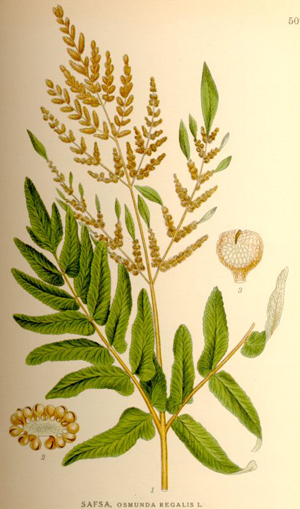|
Hardy Fern Home All Ferns Fern Families ��Aspleniaceae ��Blechnaceae ��Dennstaedtiaceae ��Dryopteridaceae ��Lygodiaceae ��Osmundaceae ��Polypodiaceae ��Pteridaceae ��Thelypteridaceae ��Woodsiaceae Fern Genera ��Adiantum ��Arachniodes ��Aspidotis ��Asplenium ��Astrolepis ��Athyrium ��Blechnum ��Cheilanthes ��Cryptogramma ��Cyrtomium ��Cystopteris ��Dennstaedtia ��Deparia ��Diplazium ��Dryopteris ��Gymnocarpium ��Lygodium ��Matteuccia ��Onoclea ��Oreopteris ��Osmunda ��Pellaea ��Phegopteris ��Pleopeltis ��Polypodium ��Polystichum ��Pteridium ��Pteris ��Pyrrosia ��Thelypteris ��Woodsia ��Woodwardia |
| Osmundaceae | ||
|
Dimorphic fronds, the absence of sori, green spores, and simultaneous maturation of spores. Here only Osmunda.
| ||
| Osmunda | ||
Royal fern | ||
|
Etymology
Of uncertain derivation: from Latin os, bone + munda, cure, because the root was a remedy for rickets; or perhaps from mundae to clean, as it was used medically to clean bones. Perhaps from Osmunder, the Saxon god of war.
Description
Rhizome: erect, massive, forming a trunk, occasionally branching, hairs and old stipe bases woven together with black, fibrous roots.
Frond: deciduous, dimorphic. Stipe: stipules (flared leaf base), unique to the family/genus, hairy when young, vascular bundles: 1 in a U-shape where the top of the arms continue to curl. Blade: 1-2-pinnate, rachis grooved, somewhat waxy, shedding water, reddish to light brown hairs. Pinnae: catadromous, often jointed at the rachis, veins free, forked. Sori: none, indusium: absent, sporangia: large, globose, tan or black when mature, spores green.
Distinctive Characteristics
The winged stipes, the vascular bundle, and the large naked sporangium without sorus or indusium, are all unique characters.
|
|
|
